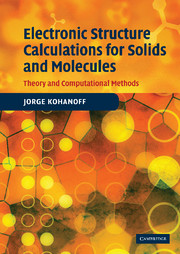Book contents
- Frontmatter
- Contents
- Preface
- List of symbols
- List of acronyms
- Part I Theory
- Part II Computational methods
- 6 Solving the electronic problem in practice
- 7 Atomic pseudopotentials
- 8 Basis sets
- 9 Electronic structure methods
- 10 Simplified approaches to the electronic problem
- 11 Diagonalization and electronic self-consistency
- 12 First-principles molecular dynamics (Car–Parrinello)
- Index
7 - Atomic pseudopotentials
from Part II - Computational methods
Published online by Cambridge University Press: 29 May 2010
- Frontmatter
- Contents
- Preface
- List of symbols
- List of acronyms
- Part I Theory
- Part II Computational methods
- 6 Solving the electronic problem in practice
- 7 Atomic pseudopotentials
- 8 Basis sets
- 9 Electronic structure methods
- 10 Simplified approaches to the electronic problem
- 11 Diagonalization and electronic self-consistency
- 12 First-principles molecular dynamics (Car–Parrinello)
- Index
Summary
The wave functions for free electrons in a periodic crystal can be expanded in plane waves (PWs). If the potential due to the atoms is neglected, then PWs are the exact solution. If the potential is reasonably smooth, then it can be treated as a perturbation, thus leading to the so-called nearly-free electron model (see Section 6.2). The potential originated in the atomic nuclei, however, is far from smooth. In the simplest case of hydrogen the potential is –1/r, which diverges at the origin. The 1s wave function does not diverge, but it exhibits a cusp at the origin, and decays exponentially with distance. For heavier atoms the wave functions associated with core states are even steeper. Therefore, a PW expansion of the wave functions in a real crystal is a rather hopeless task, because the number of PW components required to represent such steep wave functions is huge. However, it would be desirable to retain the simplicity of the PW approach. Slater (1937) suggested a possible solution to this problem, where the PW expansion was augmented with the solutions of the atomic problem in spherical regions around the atoms, and the potential was assumed to be spherically symmetric inside the spheres, and zero outside (APW method).
In order to overcome this shape approximation of the potential, Herring (1940) proposed an alternative method consisting of constructing the valence wave functions as a linear combination of PW and core wave functions. By choosing appropriately the coefficients of the expansion, this wave function turns out to be orthogonal to the core states. Hence the name of orthogonalized plane wave (OPW) method.
- Type
- Chapter
- Information
- Electronic Structure Calculations for Solids and MoleculesTheory and Computational Methods, pp. 143 - 177Publisher: Cambridge University PressPrint publication year: 2006

